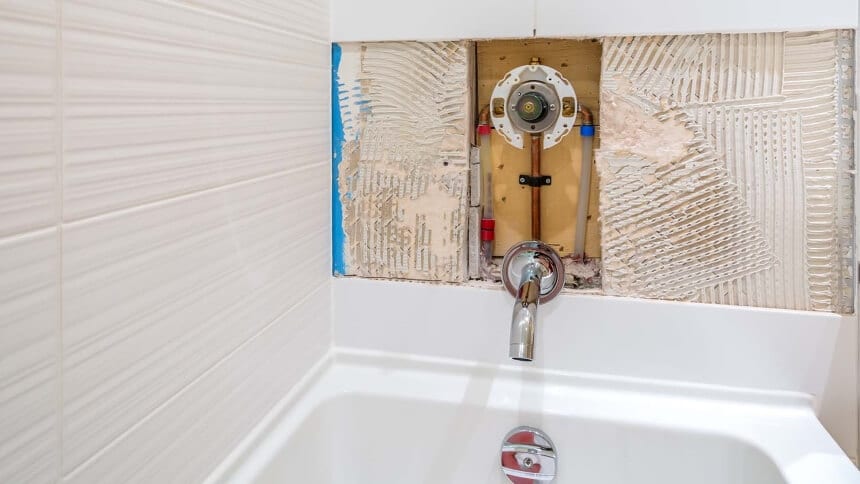Parts of shower valve include the components that control water flow from the showerhead, spout, or handheld spray. The components control the shower’s temperature as well. When properly installed, modern shower valves allow you to take a bath more comfortably by reducing sudden fluctuations in temperature and water pressure. In most cases, shower valves are mounted behind the wall. Shower valves come in two types, each with its own parts.
There are various components to the shower valve, which regulate how much water comes from the shower head. Through the shower valve, you may also modify the temperature of the water. When taking a full bath, water will first stream from the bathtub spigot before flowing from the ceiling. Lifting the spout that delivers water to the shower head does this. Different parts of shower valves are provided by several Suppliers and Companies, different manufacturers, and a lot of distributors and there are a lot of Shower Valves for Sale on Linquip.
The Linquip website offers a comprehensive list of services that address all your requirements. Vendors for Linquip can help you with this. For more information on how to connect with a varied set of service providers who consistently produce high-quality goods, please get in touch with Linquip’s Valve Experts.
Throughout this article, we will go over a good deal of information about these parts.
How We write about Parts of Shower Valves
Shower valves are an essential part of any bathroom. They control the flow of water and help regulate the temperature of your shower. At Linquip, we understand the importance of knowing the different parts of shower valves. That’s why we have written a blog post about it.
Our blog post covers all the different parts of shower valves, including the handle, cartridge, trim plate, and valve body. We also explain how each part works and what to look for when selecting a shower valve.
Writing this blog post was an exciting experience for us. We learned a lot about shower valves and how they work. We also had the opportunity to test out different shower valves and see how they performed in real-world situations. We believe that our blog post will provide you with valuable information about shower valves and help you make an informed decision when selecting one for your bathroom.
Basics of Shower
A shower is an essential part of every bathroom. In ancient times, people liked to soak in waterfalls and stand under them to take showers. Modern civilization has provided us with indoor plumbing and a most luxurious and comfortable shower. When you’re taking a shower, water is sprayed on you, and you can choose the temperature of the water based on your preferences. Many of us are unfamiliar with the components of a shower, even though we use them daily. Parts of shower include:
- Shower Head
- Shower Valve
- Shower Pan
- Water Supply
- Pipe
- Shower Drain / Shower Strainer
- Shower Cartridge
- Shower Hose
- Waste Outlet Pipe
- Shut-Off Valves
Below is a diagram showing where the different shower parts are installed.
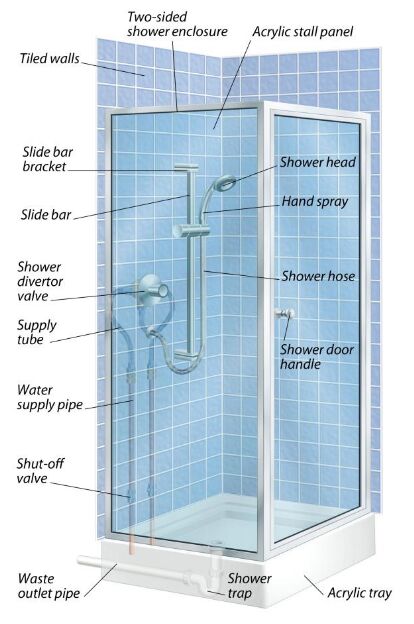
A shower valve is a fundamental part of the system, which will be described in more detail below.
Shower Valve
In a shower, the shower valve controls how much water flows from the shower head, and there are several parts of the shower valve. You can also adjust your water’s temperature through the shower valve. With a full bath, you will see water pour out of the bathtub spigot before it flows out of the overhead. This is done by lifting the spout that directs the water to the shower head.
The shower is also equipped with a cartridge that regulates the temperature and water flow. You pull the shower handle to move it forward or backward. Drainage is done through the shower strainer. You find it on the shower floor as a drain cover. Thus, any object that could possibly clog the drain is blocked. They come in a wide range of designs and finishes.
An overview of the various components of a shower valve can be seen in the following figure; however, the components may vary according to valve type.
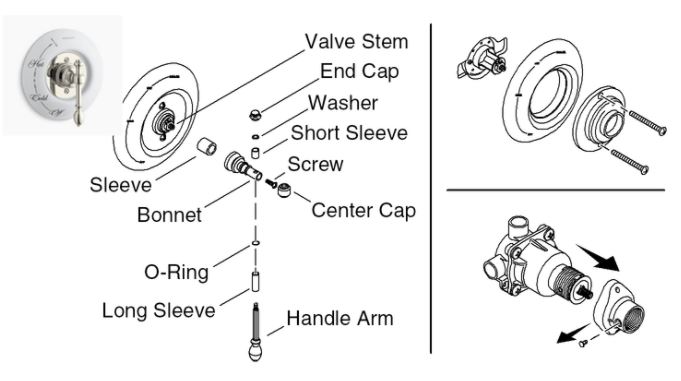
Shower valves can be divided into two main categories based on their functionality: thermostatic valves, which regulate temperature, and manual valves which do not. As soon as you’ve decided which of these types of shower valves you want, you’ll be able to move on to the more detailed decisions, including choosing the design of your valve. This article explains the basic features and parts of different shower valve types and helps you decide which type is best for your family, your budget, and your time.
Can Shower Valves Be Repaired?
Shower valves might get broken; you must get a replacement right away to stop total water leakage. Although this is a significant issue, you may resolve it on your own without a professional plumber’s assistance. All you have to do is be meticulous and make sure nothing gets overlooked.
Shower Valve Parts According to Valve Types
Depending on valve types, parts of the shower valve may vary.
Thermostatic Shower Valve
By using a thermostatic valve, you can make sure that the water temperature of your shower is maintained, so once you choose a temperature setting for the shower when you turn it on, it won’t surprise you by abruptly getting hotter or colder as you take a shower. In showers without thermostatic shower valves, you may have noticed that if someone in the same building flushes the toilet or turns on the kitchen faucet, your shower will suddenly shock you with a cold blast of water. This will not happen with a thermostatic shower valve.
It is useful for ensuring that you have a pleasant shower experience, but it is also particularly useful if you have children to avoid scalding hot water or freezing water.
Shower valves of this type typically have two handles:
- A handle to control the water flow
- A handle that controls the temperature.
In this case, you can keep the temperature you have set in the same position at all times, after which you will only need to use the on/off handle to control the flow volume. As a result, users will save time and frustration on finding the ideal temperature for each shower.
Thermostatic shower valves are available in a variety of styles to suit the needs of homes of different types. They include:
Twin Thermostatic Shower Valve
There are two controls on this thermostatic shower valve:
- One that controls temperature
- One controls the flow
This valve can control a single shower. It could be used for an overhead shower.
Twin Thermostatic Shower Valve with Diverter
In a double shower, this valve controls an overhead showerhead as well as a handheld wand. Despite this, water cannot flow simultaneously from both heads with this valve; instead, you must choose which shower you wish to use.
There are two handles on this valve:
- One handle turns the shower on or off, as well as lets you select one shower head from another.
- You can also adjust the water’s temperature with the other handle.
Triple Thermostatic Shower Valve
With this type of shower valve, two showers can run simultaneously when you have a double shower. These showers usually consist of a fixed overhead shower head as well as a handheld wand.
Each of these valves has three handles:
- One of which controls the temperature, ensuring that the temperatures of both showers will be identical and steady.
- Two remaining handles will allow you to control the water flow and turn the showers on and off so that you can isolate each shower and use it independently based on your needs.
Triple Thermostatic Shower Valve with Diverter
Three separate shower outlets can be controlled by this kind of valve. Typically, this would consist of an overhead showerhead, a handheld wand, and body jets that are mounted on the wall. This type of shower valve has three handles:
- The temperature of all the outlets can be controlled by one of the handles.
- In addition to controlling the flow of water, one independently operates the body jets to switch on or off.
- Lastly, there is an on/off switch for the two remaining outlets and a switch for switching between them.
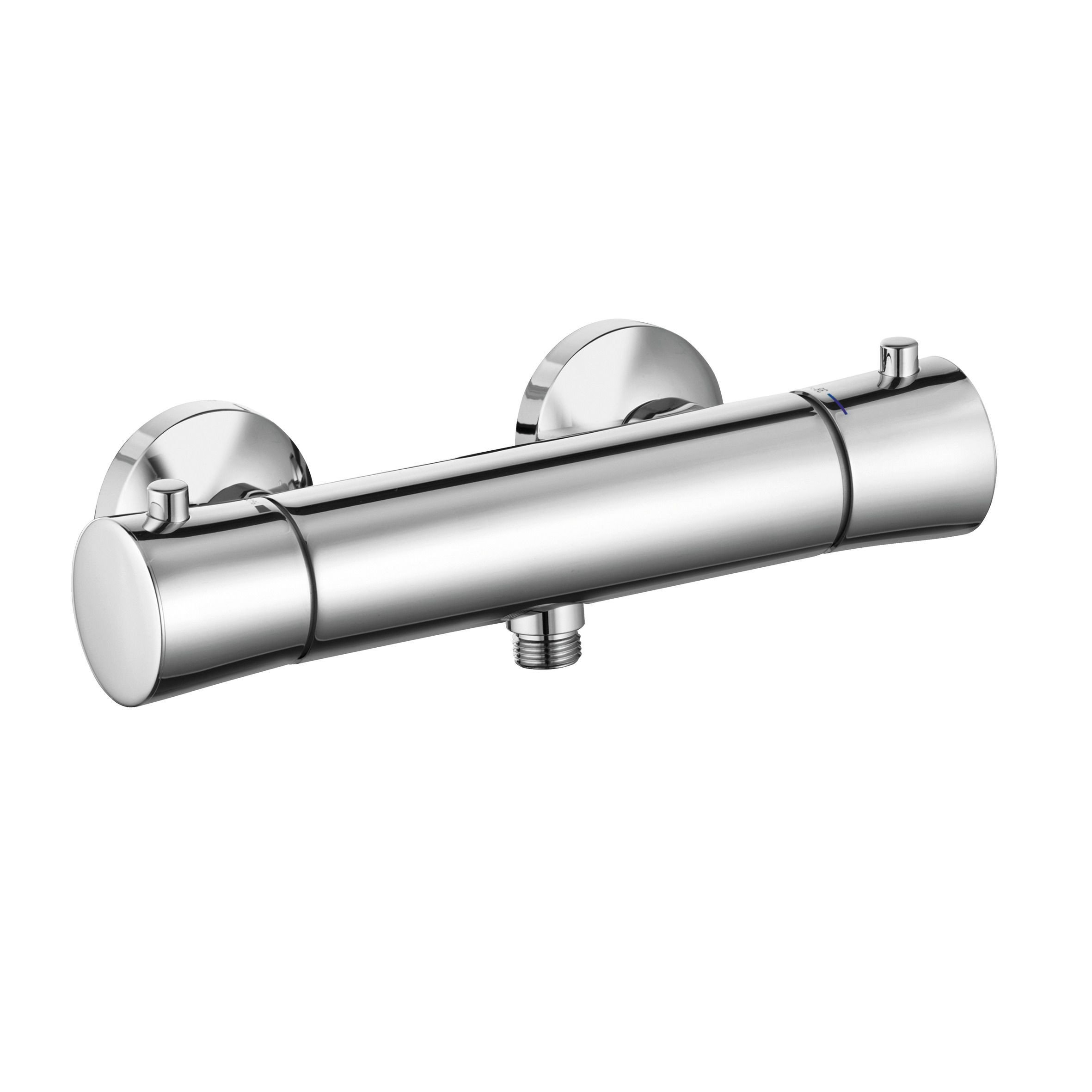
Manual Shower Valve
In today’s world, manual shower valves are considered an old-fashioned fixture, but they are still very popular because of their simplicity. There is only one handle on this type of shower valve that controls both water temperature and water pressure, in addition to turning on and off the shower.
Shower valves of this type are problematic, especially when they are used in households with children or elderly people because they don’t maintain and regulate the temperature of the water. As a result, the temperature of the water in a shower can momentarily rise or fall when a tap in the house is turned on or a toilet is flushed.
In addition to presenting an unpleasant surprise, this can pose a serious threat to vulnerable individuals since the water is often hot enough to burn. Due to this reason, these types of shower valves aren’t recommended for families with small children.
Additionally, these types of valves have no preset temperature, so you have to find the sweet spot on the handle to get the water to a temperature you prefer every time you get into the shower. Obviously, this is more of an inconvenience than a serious problem, but if you require to hop in and out of the shower promptly in the morning, then it could waste time.
Typically, manual shower valves are the cheapest types of shower valves and are very low cost. It will be okay to use this type of shower valve if you are not planning on using it on small children and you are setting up your bathroom on a tight budget.
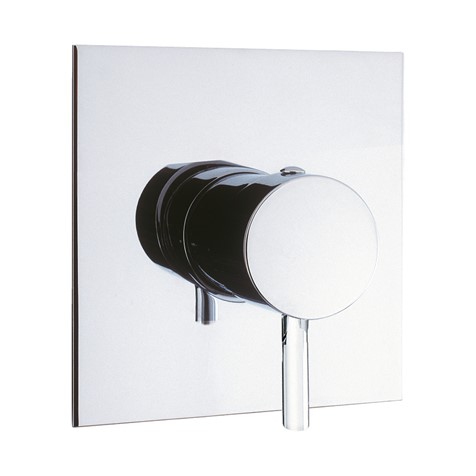
FAQs about Shower Valve Parts
What are shower faucet cartridges?
In a faucet or shower assembly, a faucet cartridge or stem controls how much and how fast water flows. A stem diverts water from a spout to a shower head in some shower applications.
Which types of stems are there for shower valves?
Shower valves can be divided into three types: pressure-balancing shower valves, thermostatic shower valves, and diverter shower valves.
What is the body of a shower valve?
It is the brass fixture inside the shower wall that mixes hot and cold water to make sure that you have a comfortable warm shower every morning. The shower rough-in valve mixes hot and cold water and delivers it to the showerhead or faucet after mixing them.
How does a shower faucet diverter work?
In a combination bathtub/shower, you can change the flow of water by turning your faucet handle to change it from the tub’s spout to the showerhead, or vice versa. Through this handle, you activate the shower diverter built into the wall, which directs water flow.
Conclusion
We have tried to describe in this post the various parts of the shower valve, based on its type. We also provided a general description of shower valves. Linquip’s Valve Experts are available to answer any questions you may have regarding the best valve for your shower. The Linquip website also offers a large selection of Valve Service Providers if you need any specific repair or maintenance services for your shower valve.
Video for Parts of Shower Valve
With this video, you’ll get an in-depth description of shower valves. It will definitely help you put the knowledge you gained in this post into practice.
Download PDF for Parts of Shower Valve
By clicking on the link below, you can download the PDF version of this post if you would like to read it again and use it for future reference.
linquip.com-Parts of Shower Valve Name amp Diagram
Buy Equipment or Ask for a Service
By using Linquip RFQ Service, you can expect to receive quotations from various suppliers across multiple industries and regions.
Click Here to Request a Quotation From Suppliers and Service Providers
Read More In Linquip
- Best Check Valve for Sump Pump: 9 of the Best Models
- Air release valve Manufacturers
- Globe Valve Manufacturers
- Butterfly Valve Manufacturers
- Needle Valve Manufacturers
- Plug Valve Manufacturers
- Parts of Sprinkler Valve
- Parts of Check Valve
- Parts of Gate Valve
- The 10 Best Shower Valves of 2021
- 6 Parts of Butterfly Valve + Function: A complete guide!
- Backflow Valve Installation, Costs and Maintenance
- How to Install a Thermostatic Mixing Valve? (Costs and Maintenance)
- How to Install a Water Pressure Reducing Valve? (Costs and Maintenance)
- Check Valve Installation Costs and Maintenance
- The 10 Best Water Shut off Valves
- What is Drain Valve? Working Principle, Types & Applications
- What are Coaxial Valves? Working Principles and Type
- What is Isolation Valve? Working Principle & Types
- Backwater Valves: Working Principles & Types

